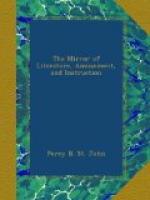* * * * *
RETROSPECTIVE GLEANINGS.
THE BISHOPRICKS OF ENGLAND AND WALES
Were instituted according to the following order of time, viz. London an Archbishoprick and Metropolitan of England, founded by Lucius, the first Christian king of Britain, A.D. 185; Llandaff, 185; Bangor, 516; St. David’s, 519. The Archbishoprick of Wales from 550 till 1100, when the Bishop submitted to the Archbishop of Canterbury as his Metropolitan; St. Asaphs, 547. St. Augustine (or Austin) made Canterbury the Metropolitan Archbishoprick, by order of Pope Gregory, A.D. 596; Wells, 604; Rochester, 604; Winchester, 650; Lichfield and Coventry, 656; Worcester, 679; Hereford, 680; Durham, 690; Sodor and Man, 898; Exeter, 1050; Sherborne (changed to Salisbury) 1056; York (Archbishoprick) 1067; Dorchester (changed to Lincoln) 1070; Chichester, 1071; Thetford (changed to Norwich) 1088; Bath and Wells, 1088; Ely, 1109; Carlisle, 1133. The following six were founded upon the suppression of monasteries by Henry VIII.—Chester, Peterborough, Gloucester, Oxford, Bristol, and Westminster, 1538. Westminster was united to London in 1550.—Vide Tanner’s Notitia Monastica.
C. G. E. P.
* * * * *
ADDINGTON, SURREY.
The lord of this manor, in the reign of Henry III. held it by this service, viz. to make the king a mess of pottage at his coronation; and so lately as the reign of Charles II. this service was ordered by the court of claims, and accepted by the king at his table.
C. G. E. P.
* * * * *
THE BELL-SAVAGE INN
On Ludgate-hill, has, for more than a century, since its name was mentioned by Addison in the Spectator, occasioned a great variety of conjectures. These conjectures, however, all appear to have been erroneous, as the inn took the addition to its name from its having belonged to, or been kept by, a person of the name of Savage. The sign originally appears to have been a bell hung within a hoop, a common mode of representation in former times. This origin has been proved by a grant in the reign of Henry VI. in which John French, gentleman of London, gives to Joan French, widow, his mother, “all that tenement or inn called Savage’s Inn, otherwise called the Bell on the Hoop.” In the original “vocat” Savagesynne, alias vocat “Le Belle on the Hope.” Perhaps the phrase “Cock-a-Hoop,” may be derived from the sign of that bird standing on a hoop, thus most conspicuously displaying himself, as we find that sign or rather design existed in the reign above mentioned.
* * * * *




